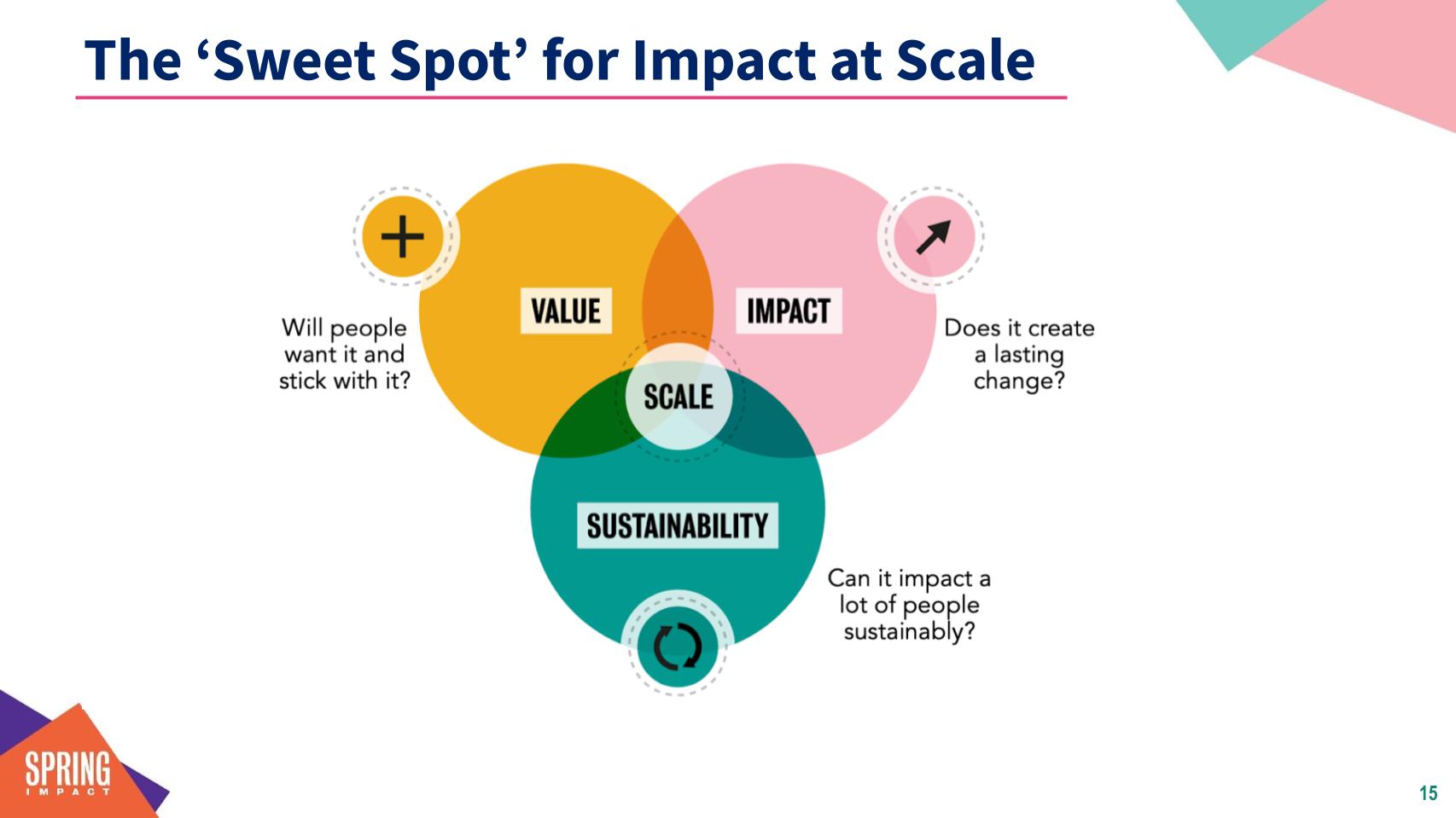Purpose
This was a Masterclass focused on building hands-on knowledge on how to scale up solutions – translating theory to practice.
 Presenters
Presenters
Nora Dettor, Director of Capacity Building, Spring Impact
Alice Metcalf, Senior Consultant, Spring Impact

Finding the sweet spot for scale
Spring Impact’s sweet spot for scaling framework forms a great benchmark that shows the three things that practitioners and organizations need to get right at scale; impact, value and sustainability.
- Impact – is the solution impactful? Does it actually make people’s lives better? Does it help address societal problem?
- Value – will people want it and stick with it? We need to validate that people actually want and demand the solution. Do they engage with it over time?
- Sustainability – of a solution is critical to scale. Can the solution impact a lot of people sustainably? Its important to understand what the costs are and where the resources are going to come from to cover these costs.

“Without a route to sustainable income you will only create a bigger fundraising target the more you scale. It becomes like you creating a monster that you can’t afford to feed,” – Nora Dettor.
Examples of solutions that achieved impact at scale
Harambee
- Meaningful In response to the unemployment societal problem in South Africa Harambee created a youth employment accelerator.
- The programme has created a lasting change, by helping 1 million jobseekers in 10 years.
- The employment accelerator was valued by job seekers in that they could join a network get support, training, and career opportunities
- Its sustainable because they receive fees from employers as well as funding from government contracts.
Alcoholics Anonymous (AA)
- AA impact is proven as their programme outperforms other alcohol use disorder treatments at 24 and 36 months. 69% of participants are sober for one year or more.
- AA validated their value by having an average attendance of 2.5 meetings per week and over 30% of new members come from existing member referrals.
- In terms of sustainability, the funding required is 100% funded by donations from people who benefit from AA. All community groups are self-funded and supported.
Centrs Dardedze
Centrs Dardedze is a successful Latvian NGO addressing unsafe relationships and child abuse in Latvia. Centrs Dardedze developed the Džimba programme that teaches kindergarten and primary school children about personal safety and safe relationships in an engaging and exciting way. Read the case study on how they found the ‘sweet spot’ between the value, impact and sustainability of their programme so they can scale up sustainably.
Key Points
- Scale is concerned with increasing the impact on addressing a problem i.e serving a problem rather than growing something.
- Scaling helps practitioners and organizations increase the impact of their solution and reach more people.
- When done badly, scale takes the form of someone ‘airdropping a solution’ into a new context and expecting it to work there without considering the needs of the people and how they experience the problem.
- A solution at scale must have value to the people it targets. The targeted people should demand and want to interact with the solutions at scale.
- A part of the scale process is making sure the solution would be impactful, valued and sustainable in any new context it is scaled to.
- To establish if your impact can be sustained at scale, you must determine if your solution need to exist forever, the payer and doer at scale and the implications for how you scale.
How to establish the Doer and Payer at scale
To establish how your impact can be sustained at scale, here are key questions to answer;
- Does your solution need to exist forever to achieve your intended impact?
- Who will be delivering the solution at scale?
- Who will be paying for the solution at scale?
- What is the role of your organization and other stakeholders at scale?
- What are the implications for how you scale?




